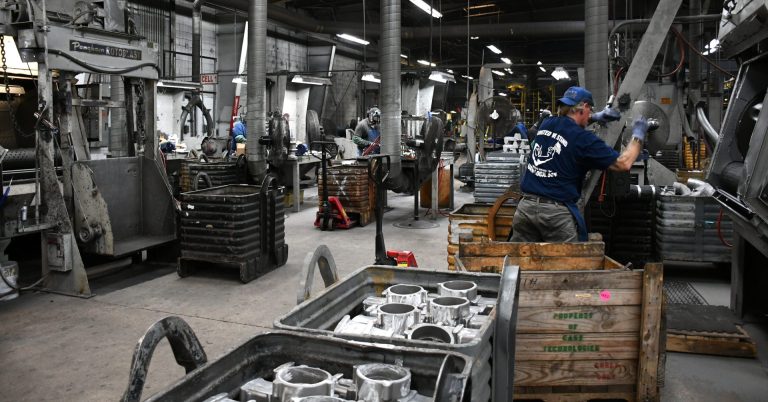Aluminum Casting Demystified: Secret Techniques for Success
Wiki Article
Dive Into the Globe of Aluminum Spreading: Understanding the Different Methods
Light weight aluminum spreading is a basic procedure in the production market, with numerous approaches utilized to produce precise and elaborate parts. Understanding the various methods made use of in aluminum casting can supply important insights right into the abilities and constraints of each method. From the traditional sand spreading method to the advanced die casting process, each approach provides special benefits depending upon the demands of the project. Discovering these diverse approaches can use a detailed view of the opportunities within the world of light weight aluminum spreading and exactly how each strategy contributes to forming the contemporary production landscape.Sand Spreading Method
Sand casting, a widely-used technique in light weight aluminum casting processes, includes developing mold and mildews made of compacted sand for putting liquified steel. This method is cost-effective and extremely versatile, making it a preferred option for various sectors. The procedure begins with the development of a pattern, typically made of wood or steel, which is after that pushed right into the sand to leave an impact. The sand mixture, normally silica sand mixed with a binder like clay, is firmly packed around the pattern to develop a mold and mildew tooth cavity. As soon as the mold is ready, it is securely placed in a flask and molten aluminum is poured right into the cavity.After the metal has cooled and strengthened, the sand mold is escaped to expose the light weight aluminum spreading. Sand spreading enables for the production of complicated shapes and large parts that might be hard or expensive to generate utilizing other approaches. It is additionally a lasting technique as the sand can be recycled and made use of several times, minimizing waste in the spreading procedure.
Permanent Mold Method

One considerable benefit of the Long-term Mold And Mildew Strategy is the boosted dimensional precision it supplies. The steel mold and mildew enables for tighter resistances and finer details in the final aluminum castings contrasted to sand spreading techniques. This accuracy makes it a favored option for applications where tight dimensional control is essential, such as in the automobile and aerospace markets.

Pass Away Casting Refine

Financial Investment Casting Strategy
Utilizing an accuracy casting approach, Investment Casting Strategy entails developing detailed aluminum parts by putting liquified steel right into a ceramic mold and mildew. This process, also recognized as lost-wax casting, starts with the production of a wax pattern of the wanted part (aluminum casting).The following action includes putting the molten aluminum into the ceramic mold and mildew. The light weight aluminum fills the More Info dental caries left by the wax pattern, taking its form precisely. This technique is preferred for its capability to create intricate forms with high precision and a smooth surface finish. Financial investment casting is frequently used for manufacturing components in markets where tight resistances and elaborate layouts are required, such as aerospace, vehicle, and medical equipment. The adaptability and accuracy of the Financial investment Casting Strategy make it a valuable strategy worldwide of light weight aluminum spreading.
Lost Foam Spreading Technique
Having actually discovered the detailed precision of Investment Casting Strategy, the emphasis now moves to the cutting-edge method of Lost Foam Spreading in light weight aluminum element manufacturing. Lost Foam Casting, also known as evaporative pattern spreading, is a modern-day strategy where a foam pattern of the wanted component is produced and then covered with a refractory material.In Addition, Lost Foam Casting is a more information cost-efficient process as it reduces the demand for cores and enables for the manufacturing of lightweight elements. Despite its advantages, Lost Foam Spreading needs mindful control of the casting procedure to prevent flaws and ensure quality elements.
Verdict
To conclude, light weight aluminum casting useful content offers a selection of methods such as sand spreading, irreversible mold strategy, pass away spreading, investment casting, and lost foam casting. Each technique has its very own benefits and applications, making aluminum casting a flexible and extensively used process in different sectors. Recognizing the differences between these techniques is crucial in selecting the most appropriate spreading strategy for specific production requirements.Sand casting, a widely-used technique in light weight aluminum spreading procedures, entails developing molds made of compacted sand for pouring molten metal. aluminum casting.The Permanent Mold Method, like sand casting, is one more common technique utilized in light weight aluminum casting processes, using unique benefits in terms of mold reusability and dimensional accuracy. The metal mold allows for tighter tolerances and better information in the last light weight aluminum spreadings compared to sand casting methods. The two main kinds of die spreading are chilly chamber pass away casting and hot chamber die spreading, each ideal for various types of aluminum alloys.In conclusion, aluminum spreading supplies a selection of techniques such as sand casting, permanent mold and mildew strategy, pass away casting, investment casting, and lost foam casting
Report this wiki page